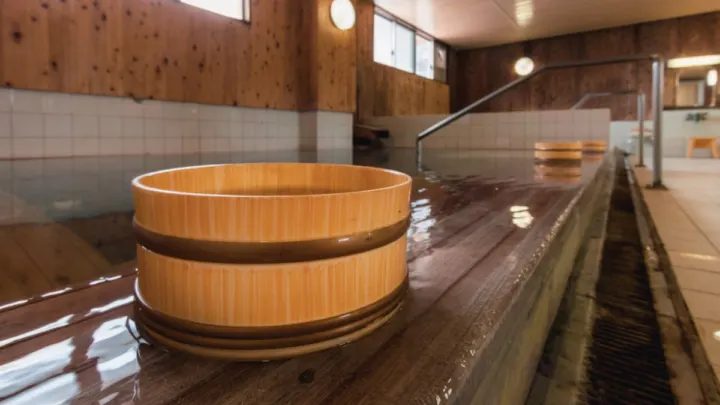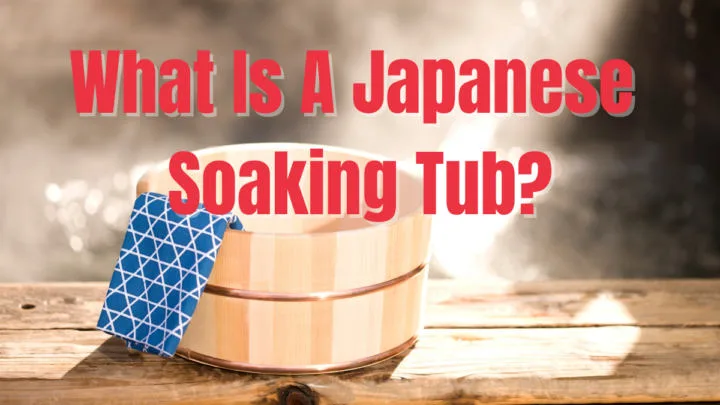Imagine getting home from a tough day at work only to relax in a hot bath in a Japanese hot tub.
The feeling is so tranquilizing that the Japanese soaking tub will become an essential part of your daily routine, even if it is only for 15 minutes.
The relaxation that you got from the traditional bathtub will seem underwhelming once you experience the relaxation that is the Japanese soaking tub.
But what is a Japanese soaking tub exactly?
A Japanese soaking tub is a tub that allows you to sit down on a bench seat as you soak. One can sit in the bath immersed up to their chest or shoulders.
The traditional bathtub is slanted from one end to allow your back to rest.
Table of Contents
Experience the benefits of a spa-like retreat in the comfort of your own home with a specialty tub. My guide, “What Is A Soaking Tub” covers everything you need to know to make an informed decision!
History Of The Japanese Soaking Tub
Since Japanese soaking tubs are all the rage in home bathing and are a stylish and contemporary bathroom accessory, you should probably know their origins.
Japanese soaking tubs have been around for some time, even though they have only just recently made their way into bathroom décor in the West.
This tub style has stylized Japanese homes since 1964 and is a part of their culture.
This bathtub was used to cleanse the body and purify the soul when the ceremonial ritual of purification was conducted.
The ceremony included detoxifying the body with dead sea salts rather than soap.
This cleansing routine was considered to have therapeutic benefits.

Benefits Of A Japanese Soaking Tub
Many people in the US are still unfamiliar with the Japanese soaking tub.
Here are some of the benefits of a Japanese soaking tub other than its sit-in feature:
1. Comfort
Apart from being hyped as the latest trend in home bathing, Japanese soaking tubs offer a deeply relaxing bath.
Since the normal bath is designed so that the legs are stretched out, and the shoulders are propped slantingly at the back of the tub, you might feel that it is the ultimate way to relax.
However, the Japanese soaking tubs are a whole new perspective to relaxing and unwinding.
The posture is comfortable because your head and shoulders are supported by the spine as they naturally are, allowing you to rest in the tub longer than in the old bath tubs.
Since there’s no pressure on your neck to make you feel strained, the comfort of the Japanese soaking tub is unmatched.
2. Space-Saving
Since the Japanese soaking tub is designed for sitting rather than stretching out, it is also a space-saving addition to your bathroom.
Placing them in a small bathroom, or in fact in any place, be it corners, submerged in the floor, or majestically placed in the center of the bathroom is possible.
So, its design is suitable for any design type and bathroom size.
Also, many new designs come with grab rails, jets, and faucets to further enhance your bathing experience.
You can also have a shower fitted at the top along with other customizations, which can allow you to enjoy the water drizzling from the top as you relax.
3. Contemporary Style
The origin of the Japanese soaking tub was the Ofuro one, which had wooden square sides.
Since then, this soaking tub design has come a long way and now comes in various materials other than traditional wood materials like stone, concrete, steel, and different types of wood.
The contemporary Japanese soaking tub has also changed out the square sides for a magnificent curved look.
However, some may also opt for the traditional square sides for a rustic look.
With a multitude of styling options, you can complement any kind of bathroom with a Japanese soaking tub or also have it customized according to the design you have in mind.
But mind you, it can get pricier as you add in the customizations.
4. Water Capacity
With increasing environmental concerns, the Japanese soaking tub is probably the best eco-friendly alternative to a traditional bathtub.
Since it is compact, it takes up less water than a lie-in bathtub to fill the tub to the brim and soak the entire body up to the shoulders.
So every muscle can get submerged in warm water without wasting as much water as the lie-in bathtub.
5. Detoxifying and Restorative Experience
The Japanese cleansing ritual involved heating up the water to 50°C and mineralizing it with dry herbs and sea salts.
You can make yourself a cup of green tea and light a scented candle to immerse all your senses in the experience.
Since your posture will be natural, you will enjoy the benefits of sitting upright, including lower back pain, energy boost, reduction in headaches, improved circulation, and improved sleep.
You can also use a scrub to pamper your body and leave the bath with your skin feeling soft and supple.
6. Therapeutic Benefits
If you follow the Japanese rituals, you might also know that the Japanese soaking tub and cleansing routine has therapeutic benefits.
It is one of the best relaxants after a long day at work and will not only leave you feeling relaxed but can also:
- Help detoxify the body of pathogens
- Increase blood circulation, which reduces the risk of cardiovascular diseases
- Strengthens the immune system
- Drains the day’s stress
- Purifies the skin
Summing It Up Japanese Soaking Tubs
The Japanese soaking tub is not a revolution in home bathing but rather an equipment that comes from a rich cultural heritage.
Apart from allowing you to relax in your natural posture, the Japanese soaking tub also offers various other benefits.
So, apart from the vanity, the Japanese soaking tub might offer you the relaxation and unwinding you need after a hard day or even a hard week.
If you found this article helpful and would like to learn more about soaking tubs, make sure to take a look at the related posts below!


